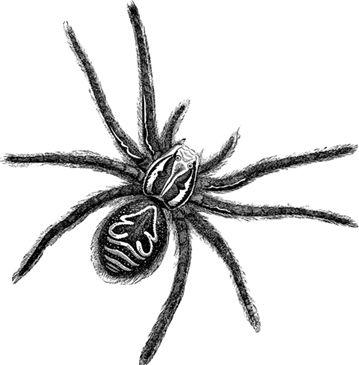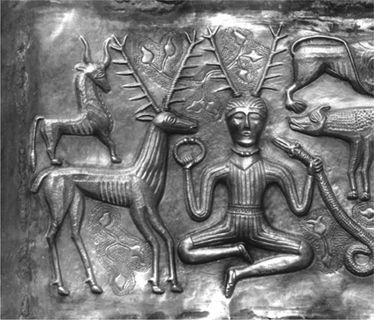The Sorcerer's Companion: A Guide to the Magical World of Harry Potter (70 page)
Read The Sorcerer's Companion: A Guide to the Magical World of Harry Potter Online
Authors: Allan Zola Kronzek,Elizabeth Kronzek

Spiders are also regarded as exemplars of many praiseworthy traits, such as patience, industry, and perseverance. According to a famous Scottish legend, King Robert the Bruce (who struggled to free his land from English rule in the 1300s) was despondent after a defeat in battle. Hiding from his enemies in a tiny hut, he lay looking up at the rafters, where a spider was trying to swing from one beam to another to establish its web. The spider tried and failed twelve times before, on the thirteenth attempt, it accomplished its goal. Bruce took this as a lesson to persevere under difficult circumstances and resumed his fight, eventually winning Scotland’s independence.

In Islamic lore, it is said that a spider helped save the life of the prophet Muhammad. As he was traveling from Mecca to Medina, Muhammad was perused by enemies and took refuge in a cave. That evening a spider spun a web across the entrance to the cave. When the pursuers arrived and saw the web, they naturally assumed no one could be inside, and moved on. Since then, spiders have held a place of respect in Muslim tradition.
All these positive associations, however, haven’t stopped modern writers and filmmakers from imagining a slew of monstrous spiders with much in common with Aragog and his descendants. In
The Hobbit
, J.R.R. Tolkien created a race of giant talking spiders that roam the forests of Mirkwood in search of tasty dwarves and hobbits. He followed that up with an even more monstrous spider, Shelob, in
The Lord of the Rings
. Oversize spiders with supertoxic venom or extra-sticky webs also appear in comic books, video games, and a seemingly endless parade of B movies, such as
Tarantula
(1955),
Earth vs. the Spider
(1958),
Kingdom of the Spiders
(1977),
Arachnid
(2001),
Eight Legged Freaks
(2002), and two Godzilla movies in which Kumonga, a spider with a 164-foot leg span, shoots heavy-duty webbing at his foes. More recently, the 2007 movie
Ice Spiders
portrays a group of Olympic hopefuls who are terrorized by genetically engineered man-eating spiders at a ski resort.
- If a spider builds a web across your front door, expect company.
- To bring good luck to a bride and groom, release spiders at their wedding.
- It’s unlucky to see a spider dropping down a thread, but lucky to see one climbing up.
- If a spider crawls on you, you will receive gifts or money from a stranger.
- How high spiders build their webs on cornstalks in the summer indicates the height of snow in the coming winter.
- A spider seen on Halloween may be the soul of a loved one watching over you.
- Walking through a spider’s web brings luck to a bride; a bride who finds a spider on her wedding dress is especially blessed.
- If you come upon a spider spinning a web, you’ll soon get new clothes.
- If a black spider drops from the ceiling, you will get good news; but if a red spider drops, the news will be bad.
- Perhaps the most common superstition of all is summed up in this old English nursery rhyme: “If you wish to live and thrive—let the spider run alive.”
For those who fear being eaten by spiders, you can always turn the tables and do what they do in Cambodia, Laos, and many parts of South America: Treat yourself to a juicy barbecued tarantula. They’re high in protein and taste like chicken.


 arry has often heard that he’s the spitting image of his father, James. He’s also inherited his dad’s taste for adventure, along with an
arry has often heard that he’s the spitting image of his father, James. He’s also inherited his dad’s taste for adventure, along with an
invisibility cloak
and a magical map that helps him bend the Hogwarts rules from time to time. When Harry learns to conjure a protective spirit called a
patronus
, he finds yet another connection to his father. Harry’s
patronus
takes the form of a stag, just as James Potter himself did when practicing the art of
transfiguration
.
Their personal connection to the stag (or male deer) puts the Potters in good company. In the legends of King Arthur, the great wizard
Merlin
transformed himself into a stag in some tales, while in others he rode upon the back of a stag, commanding obedience from a whole herd of the noble, strong-willed creatures. Throughout Celtic mythology, stags appear as supernatural creatures, often possessing the ability to magically transform into men or other animals. Cernunnos, the Celtic god of the underworld, was depicted with the body of a man and the antlers of a stag. Honored for his alertness, speed, and aggression, Cernunnos was said to rule over the hunt and to have a special affinity for all animals of the forest.

Silver figures of the sacred stag and the Celtic stag-god Cernunnos, from the 2000-year-old Gundestop Cauldron
. (
photo credit 79.1
)
Evidence from Anglo-Saxon burial grounds suggests that stags were revered in England as early as
A.D
. 300. Small models of stags have been discovered at gravesites, and in one instance a king was buried with a scepter topped with a stag. Early Christian writers complained of the Anglo-Saxon practices of displaying statues of stags at their places of worship and dressing up as stags in ritual dances. In other parts of Europe, stag antlers were hung over doorways to ward off evil influences.
During the Middle Ages, the stag often appeared in art and literature as a symbol of masculinity, solitude, strength, virtue, and purity. Because of the way its antlers are continually shed and regrown, the stag, like the
phoenix
, also came to represent the cycle of life, death, and rebirth. For hunters, the noble beast became the ultimate prize, especially for those who had heard the legend that it would grant wishes to its captors. Today, veneration of the stag lives on in the town of Abbots Bromley, England, where each September, six townsmen don antlers to perform the Horn Dance, a ritual celebration of the hunt dating back to
A.D
. 1226.


